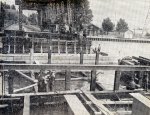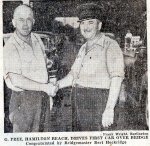A section of a Spectator history article from February 7th, 1959
By Mabel Burkholder
FOLLOWING is a letter of May 2, 1861, concerning Burlington Beach Canal tolls, from T. H. McKenzie of Dundas to Isaac Buchanan, Hamilton. It reveals the spirit of rivalry between the two places for the control of trade at the head of the lake.
"A matter deeply affecting the shipping interest of this town and community (Dundas) has lately been brought before our notice, by the proceedings of the Hamilton Corporation and Board of Trade. In reference to the reimposing of canal tolls on the Burlington Bay Canal for the benefit of Hamilton. I am quite sure you would not be a party to do an injustice to any community and you will at once see that if the Burlington Canal is to be handed over to the city of Hamilton and tolls imposed for their benefit, this town as well as all others west of this, will be compelled, to contribute to the payment if the Hamilton debt, which would be very unjust.”
"We in Dundas claim that, if this is done, a share of the tolls collected on all imports and exports to and from this town, and others, will" be absolved from all tolls inward and outward.
You will agree with me that this is only an act of justice toward us and I trust you will see that justice is done to us here, if the contemplated project is carried out."
THE TERM "reimposing" used at the beginning of the letter shows that this was not the first time tolls had been imposed at the Beach Canal. Also, we recall that it was during the 1860s that Hamilton was staggering under the burden of municipal debt, which Dundas did not wish to help lift.
Mr. Buchanan suggests to Thomas Galt, in a letter dated March 24, 1863:
"It may be found better for the city and its creditors that Hamilton should join with Dundas, and with the Great Western and Port Dover lines of railway, in agreeing to keep up, among them, the Beach Canal, thus keeping it free of toll."
On March I8, 1863. Adam Brown wrote to Isaac Buchanan, concerning the Burlington Beach Canal tolls:
"I SEE YOU GO IN for reimposing the canal tolls and, presuming that the Burlington Beach Canal, will be included in any scheme. I cannot refrain from writing you to express the opinion which I hold that such would be most injurious to us. As a question between utter ruin of the city and reinforcing canal tolls, I would, of course, choose the latter. But as there seems every probability of the city debt being settled without the aid which the canal tolls would have yielded, I respectfully suggest to you to weigh well the effects which the reinforcing of tolls would have upon our carrying trade as a shipping port and upon the now established reputation of Hamilton as a market for merchandise".
On April 18, 1863, Mr. Buchanan wrote to Mayor G. W. Burton:
"I hope that the government have carried out their promise to impose such a toll only in the case of the Burlington Canal as will suffice to keep it in repair. If this has been done, a transfer of the canal subject to that control would be infinitely preferable to the exaction of harbor dues, as under the act these could only be collected upon goods brought into Hamilton for consumption or sale."
ON MAY 14, of the same year, Mayor Burton replied to Isaac Buchanan: "It has been intimated that the grant for the repairs of the Burlington Bay Canal has been only partially exhausted, and that a considerable sum still remains on hand applicable for that object. As the government will now be relieved of their responsibility, it is assumed that this, as well as the tolls, will placed at the disposal of the city."
And so the heated discussion ended and the tolls were not imposed.

